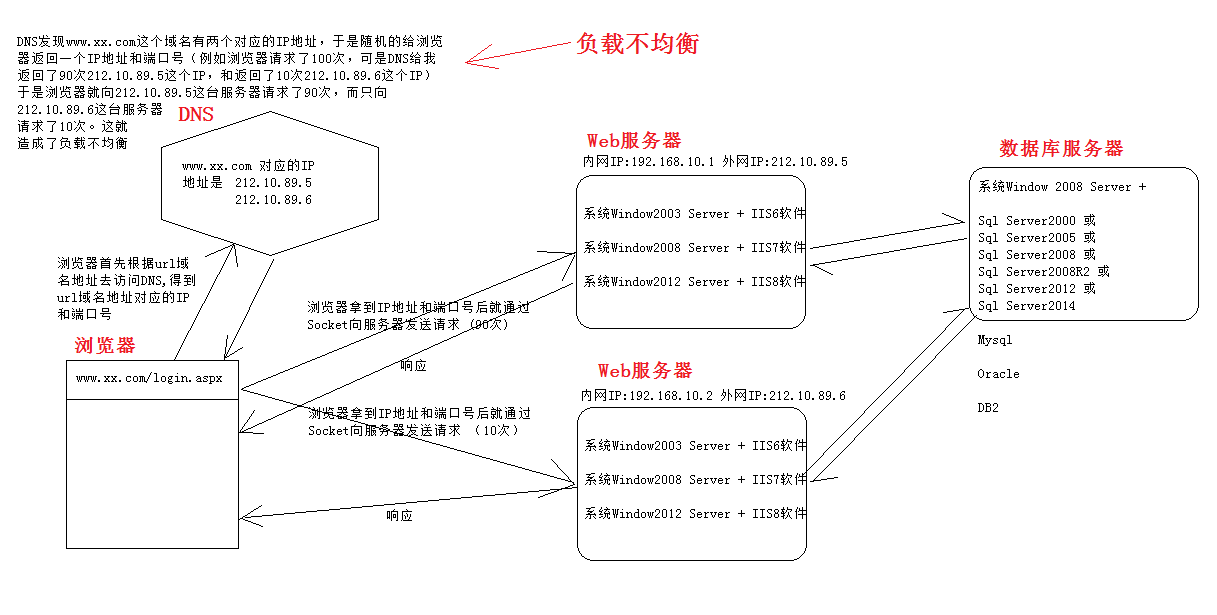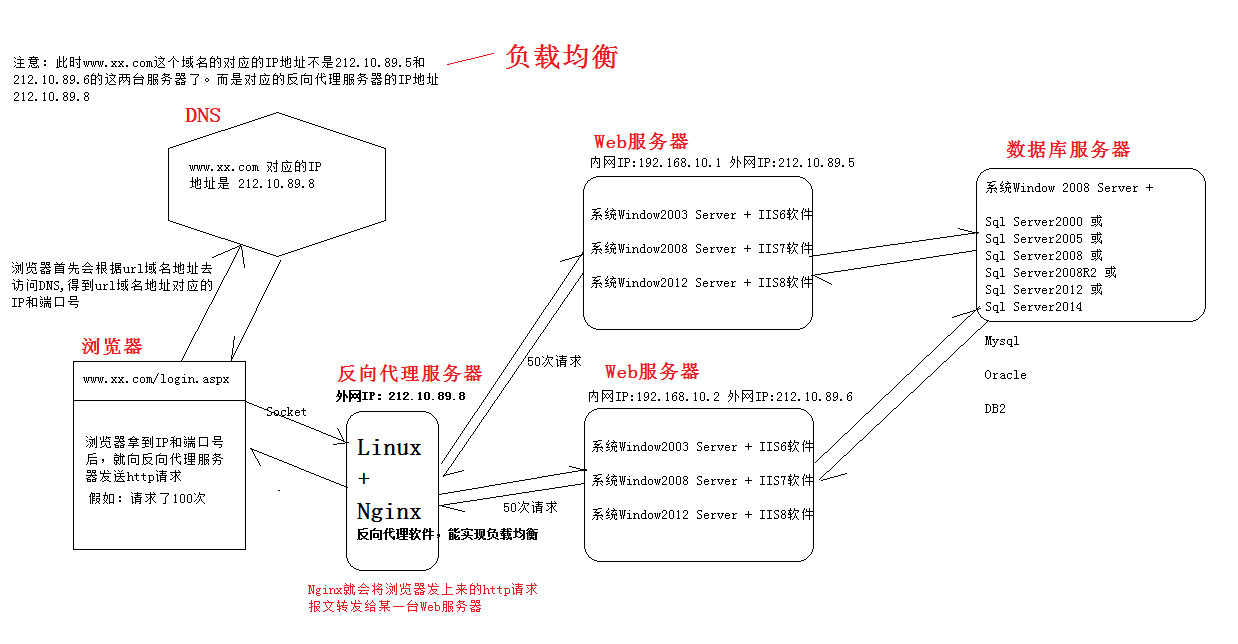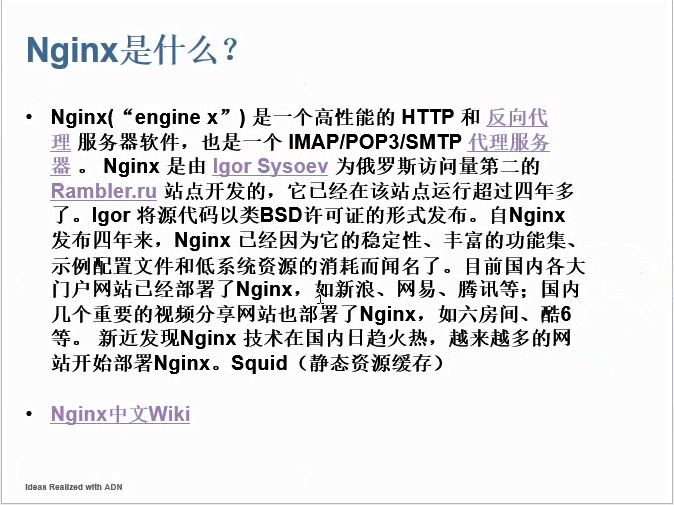分布式开发 (负载均衡图解)
2016-04-03 19:42
369 查看
Nginx反向代理以及负载均衡配置
平常我们做系统开发一般分为以下两种:第一种:企业中的管理系统:如 CRM (客户关系管理系统), OA (办公自动化系统), ERP (企业资源管理系统)
它们的特点就是:公司内部员工使用,所以访问量小。(老板要求开发速度快,所以一般用拖控件的形式进行开发,不要求性能)所以根本就用不到分布式开发,一台数据库服务器,一台IIS服务器就搞定了。
第二种:互联网系统 ,如:京东,淘宝,百度
它们的特点就是:访问量大,服务器性能要求非常高。(服务器多)
要求:分布式系统开发(服务器集群,即:很多台服务器集群在一起,来运行同一个业务)
负载不均衡图解

负载均衡图解



现在我们去下载Nginx这个软件(我们下载windows版)在Windows下来配置一个Nginx (注意:Nginx不能放在中文目录下),配置好后,“以管理员身份运行”nginx.exe文件
windows下的Nginx是这样的

然后我们打开conf文件夹,找到nginx.conf 文件,用记事本打开。然后进行配置
#user nobody;
worker_processes 1;#配置当前服务器的CPU核心数(你CPU是几核的就平配几,当然也可以配1,数字不能大于你服务器CPU的核心数,服务器一般是8核的,有的是16核的,核数越高,性能就越高)
#error_log logs/error.log;
#error_log logs/error.log notice;
#error_log logs/error.log info;
#pid logs/nginx.pid;
events {
worker_connections 1024;
}
#http表示它要监听的请求
http {
include mime.types;
default_type application/octet-stream;
#log_format main '$remote_addr - $remote_user [$time_local] "$request" '
# '$status $body_bytes_sent "$http_referer" '
# '"$http_user_agent" "$http_x_forwarded_for"';
#access_log logs/access.log main;
sendfile on;
#tcp_nopush on;
#keepalive_timeout 0;
keepalive_timeout 65;
#gzip on;
upstream testsite{ #这个upstream节点是我自己新建的,upstream这个名字是固定的,mytestsite这个名字可以随便自己取
#此处配置要做负载均衡的服务器的Ip和端口号。(其实就是你的服务器的IP和端口号)
server 127.0.0.1:8081; #我们也可以给这台服务器加个权重,可以这样配 server 127.0.0.1:8081 weight=2
server 127.0.0.1:8082; #我们也可以给这台服务器加个权重,可以这样配 server 127.0.0.1:8082 weight=1 这样的话8081这个网站请求2次后才交给8082这台服务器
}
server {
listen 8083; #Nginx监听的端口号
server_name localhost; #Nginx监听的IP地址,将来一定是要将这个localhost替换为你网站的外网IP或域名,localhost和127.0.0.1仅仅是本机测试使用(即:做反向代理服务器的IP地址,其实就是安装Nginx这个软件的这台电脑(服务器)的IP地址)
#charset koi8-r;
#access_log logs/host.access.log main;
location / {
proxy_pass http://testsite; #注意:testsite是程序员自己定义的upstream后面的名字,同时要加上http://前缀,否则报错
root html;
index index.html index.htm;
}
#error_page 404 /404.html;
# redirect server error pages to the static page /50x.html
#
error_page 500 502 503 504 /50x.html;
location = /50x.html {
root html;
}
# proxy the PHP scripts to Apache listening on 127.0.0.1:80
#
#location ~ \.php$ {
# proxy_pass http://127.0.0.1; #}
# pass the PHP scripts to FastCGI server listening on 127.0.0.1:9000
#
#location ~ \.php$ {
# root html;
# fastcgi_pass 127.0.0.1:9000;
# fastcgi_index index.php;
# fastcgi_param SCRIPT_FILENAME /scripts$fastcgi_script_name;
# include fastcgi_params;
#}
# deny access to .htaccess files, if Apache's document root
# concurs with nginx's one
#
#location ~ /\.ht {
# deny all;
#}
}
# another virtual host using mix of IP-, name-, and port-based configuration
#
#server {
# listen 8000;
# listen somename:8080;
# server_name somename alias another.alias;
# location / {
# root html;
# index index.html index.htm;
# }
#}
# HTTPS server
#
#server {
# listen 443 ssl;
# server_name localhost;
# ssl_certificate cert.pem;
# ssl_certificate_key cert.key;
# ssl_session_cache shared:SSL:1m;
# ssl_session_timeout 5m;
# ssl_ciphers HIGH:!aNULL:!MD5;
# ssl_prefer_server_ciphers on;
# location / {
# root html;
# index index.html index.htm;
# }
#}
}现在我们就来做测试:
发布两个一模一样的网站,网站1 下面有一个index.html文件。 网站2下面有一个index.html的文件
网站1的地址是 http://localhost:8081/index.html
网站2的地址是 http://localhost:8082/index.html
反向代理服务器,Nginx 监听的端口号是8083 它监听的IP地址是localhost 或者说是127.0.0.1
那么我们现在就可以用 http://localhost:8083/index.html这个IP地址来访问网站1,和网站2下面的index.html文件。(如果向这个地址请求了100次,那么肯定有50次是向网站1请求的,另外50次是向网站2请求的。这样就达到了负载均衡的目的。)
相关文章推荐
- 解决vbe6ext.olb不能被加载 内存溢出 问题
- Hadoop 生态系统中个项目的简介
- GCD使用
- 逆元的各种求解方式
- UI基础 - UITabBarController
- 第五周进度条
- Calendar Provider
- ZooKeeper
- jquery实现ajax实例
- 小题目泛做
- php笔记之表单验证
- Gridland
- MapReduce读/写RCFile文件
- 基本的排序算法
- hdu5656 dp
- _stdcall与_cdecl区别
- 2假动作,数据缓冲,CCEaseExponential,CCEaseElastic,CCEaseBounce,CCCallFunc,funcNCallBack,funcNDCallBack,funcO
- Linux第六次实验——谢飞帆
- linux 总线 设备 驱动
- linux 总线 设备 驱动
